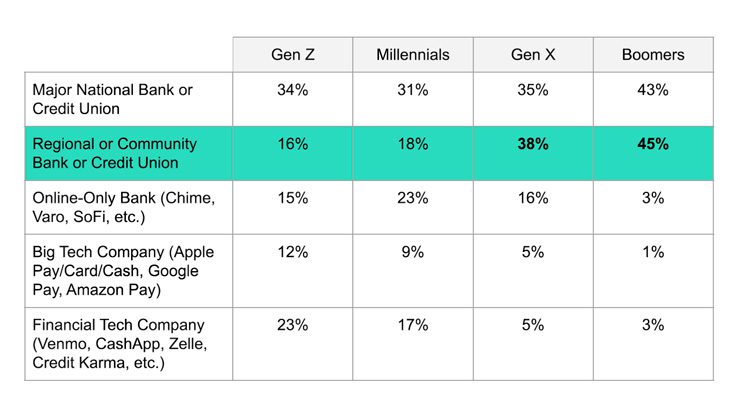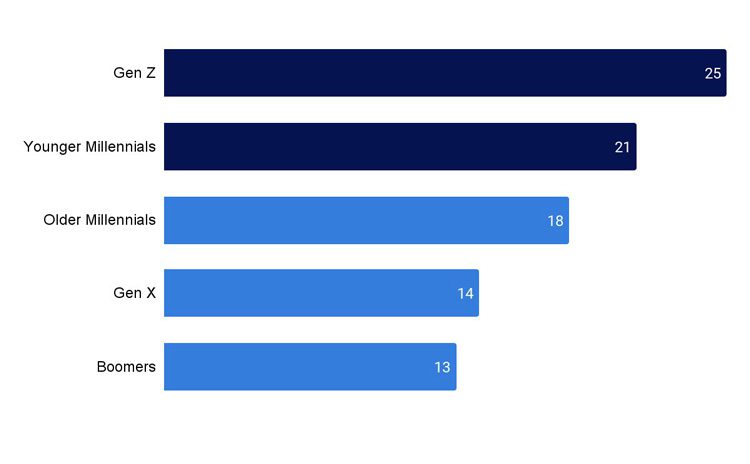Financial institutions (FIs) are at a critical moment to find and act on statistically accurate data to inform their account holder roadmap, technology plans, investments, and strategy. In our 2022 Digital Banking Transformative Trends Study with The Center for Generational Kinetics, we provide data, context, and recommendations FI leaders need for their success.
This national study includes over 1,500 U.S. participants who currently have a bank account and are active in digital banking (check account balances, transfer funds, pay bills online, etc.) and is weighted to the 2020 U.S. Census for age, region, gender, and ethnicity for a very low margin of error. At a high level, this national study uncovers numerous unexpected and important insights that can be applied to FIs of all sizes, customer or membership numbers, and geographies.
The select insights from the study shown in this blog create the context, understanding, and confidence for FI leaders at all levels to design and act on a strategy that unlocks the potential of digital banking across generations. Our last blog on this topic explored the impact of digital banking experiences today and relationships between account holders and their primary financial institutions (PFIs). Now we’ll examine the generational trends among those account holders who regularly use digital banking.
Generational trends aren’t in regional and community financial institutions’ favor
Every generation has come of age with different banking norms, behaviors, methods, memories, habits, and expectations. Some generations remember when credit cards first came out, when using checks to pay bills via mail was normal, when ATMs first ushered in the ability to get cash without going to a teller, and so much more. Each of these advancements in banking has created a more customer-centric experience allowing for greater convenience, security, transparency, and personalization. Now comes not only digital banking, but a generation of young people who may never write a check and who think carrying cash is outdated. The impact of these different banking expectations—as well as the technology that emerging generations rely upon—is clearly impacting where emerging generations go for their banking needs. But what does this mean for the banking marketplace? So far, it’s translated to generational trends not moving in the favor of regional and community financial institutions (RCFIs).
Our study finds that younger generations are significantly more likely to state that a neobank, big technology company, or fintech company is their primary financial provider. The study also reveals that RCFIs strongly skew toward the older generations of customers and members. For example, RCFIs over-index on Generation X and Baby Boomers. Neobanks, big tech companies, and fintechs over-index on Generation Z and Millennials.
As younger generations claim that non-traditional or upstart financial providers are their PFI, RCFIs face a clear imperative — act now or risk emerging generations initiating and building relationships with alternative financial providers.

The generational opportunity: younger account holders
Whoever adapts to meet the needs of young consumers will attract their business, loyalty, and future growth. The good news for RCFIs is that younger generations right now are exploring and testing out different options to determine where they want to build their longer-term primary financial relationship. At the same time, these emerging generations are increasingly earning more money and entering new, more financially complex life stages. This generational, economic, and life stage emergence makes younger generations ideal for RCFIs to attract and retain by developing and implementing new solutions specifically designed to meet the needs of emerging generations. How “up for grabs” are these younger generations when it comes to their PFI?
Our study finds that a significant portion of younger generations are unsure about the future of their PFI relationship. In fact, one quarter (25 percent) of Generation Z and 21 percent of Younger Millennials don’t think or are unsure if their PFI will remain their PFI in the next year.

Securing primacy means designing and offering a great digital experience. New expectations, norms, and trends are all showing that digital banking is critical to best serving every generation of consumer. This is true across the different types of FIs. Equally as true—and potentially even more important—is that offering a great digital banking platform is not just key to winning younger generations. In fact, delivering a great digital banking experience leads to significant gains when it comes to attracting and keeping every generation.
Our study reveals that time is of the essence when it comes to adapting to meet the digital banking expectations of every generation. Essentially, every generation wants a great digital banking solution, and the results directly correlate to key return-on-investment drivers for FIs, including greater trial, adoption, and usage of other financial products at the FI.
The insights we’ve explored so far are only a preview of the data in the full report, but one discovery is clear: digital banking now connects every generation. See more exclusive research led by Alkami in partnership with The Center for Generational Kinetics that informs the future of digital banking through a lens where every generation is valued, included, and championed.
